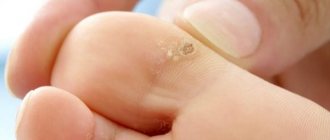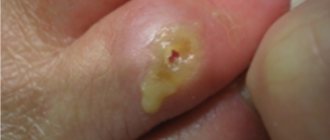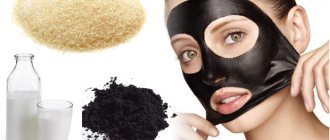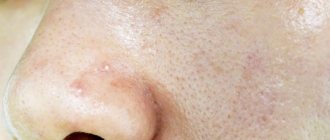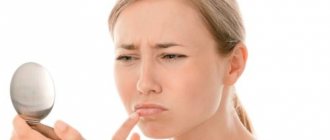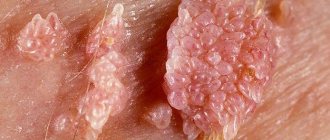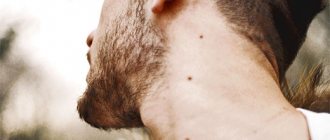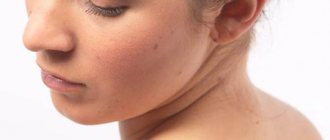Calluses that appear on the feet cause very unpleasant and painful sensations. After some time, the rubbed area hardens, continuing to cause discomfort and create an aesthetic problem. Especially often such formations form on the little finger. It will take a long time to wait for the callus to go away on its own, and sometimes this does not happen at all. Meanwhile, it is quite possible to get rid of a callus on the little toe if you make a little effort.
Types of calluses
A hard callus is a hardening of the skin that occurs in response to regular friction or pressure. This is a forced defensive reaction with which the body tries to cope with a traumatic factor. Such calluses on the toes are usually divided into several types.
- Dry callus. It is a thickening of the stratum corneum of the skin in the form of hyperkeratosis due to intense necrosis of epidermal cells with slow exfoliation and removal. This is a characteristic round yellowish formation, slightly elevated above the surface of the skin. Typically, such a callus is insensitive and does not cause noticeable pain. But if you squeeze or press it, it will become painful. Also, the callus has clear boundaries and is smooth to the touch. Often the skin around it is somewhat inflamed and swollen.
- Callus with a core. Outwardly, it is very similar to the dry form of a callus, but upon careful examination, you can notice a rod or root in its center, which is characterized by deep penetration into the underlying tissue. This callus can be compared to a mushroom, which has a cap and a stalk. By analogy, a callus can lose its cap due to medical or self-manipulation. In this case, a depression with a characteristic leg will open in the callus. The growth shaft will be swollen and red. Often ichor is released from it. When moisture gets in, the callus core softens somewhat and becomes terry. It is this that causes pain and discomfort, since it can affect nerve endings deep in the skin.
Calluses are another type of hard callus, but they usually do not occur on the fingers. Their main localization is the sole of the feet and heels. For dry or core calluses, the characteristic places of appearance are the places of greatest pressure from shoes. Often this is the big toe, as well as the ring or little finger.
Important! Dry and ridged formations are often the result of wet calluses in the form of a fluid-filled bubble. But in comparison, they are a more serious problem that requires a quick and competent solution. Otherwise, getting rid of such calluses will be incredibly difficult. In addition, there is always a risk of cracking and subsequent infection.
Types of calluses on the little finger
Various types of calluses form on the little finger. Doctors and cosmetologists distinguish between types:
- Wet callus. More often it appears due to strong friction of the skin on shoes. A wet callus looks like a blister, often painful. When you press on the blister, the pain intensifies.
- Dry callus. Formed from the wrong shoe size. As a result, the compaction on the skin gradually becomes larger. The shape of the callus is often round. Gradually a core forms inside. As a rule, it does not cause pain. If the rod irritates the nerve endings, the person feels severe pain.
- A callus is formed as a result of strong and prolonged pressure on the little finger.
- A corn is a lump on the little finger, usually on the pad. The contours of the compaction are fuzzy and blurred. The corns do not penetrate deep into the skin and cause cosmetic discomfort.
Factors that provoke the appearance of calluses
Almost every person can name the most common reason for the appearance of hard or core calluses on the toes. Of course, these are uncomfortable shoes. It is this that is usually the source of mechanical pressure and friction on the skin. Most often these are narrow toes of shoes or rough inner seams. And when wearing high-heeled shoes for a long time, the pressure increases with the load on the front of the foot, and therefore on the toes. As a result, calluses form in these places.
It should be noted that loose shoes can lead to the appearance of calluses in the toes. Sometimes this is facilitated by wearing shoes without socks or too large socks that bunch up and put pressure on the toes or rub them. With excessive sweating of the feet, excess body weight, the presence of deformities or diseases of the feet (arthritis, bursitis), the risk of the appearance of areas of hyperkeratosis increases several times.
In addition to all of the above, regular swelling, vascular pathology, calcium metabolism disorders, lack of proper hygiene and fungal infections will contribute to the appearance of dry calluses on the toes. Often such calluses arise as a result of professional predisposing factors in ballerinas, runners and skiers. And in childhood, dry or core calluses often appear after grains of sand enter the skin through scratches and microtraumas, as well as well-known splinters.
How to cure a callus that has a core in it
Under no circumstances should you self-medicate (cut off growths, cauterize with any means, apply caustic substances or ointments to it).
This can damage the skin and accelerate the formation of deep growths. By the way, you can easily find photos of such core calluses and see what it will look like. You should definitely consult a doctor. A dermatologist will conduct tests, find out the cause of the disease, and prescribe effective treatment. We should never forget that an infection (fungal or viral) can spread to other parts of the body, which will make treatment more difficult.
Professional callus removal
If you do not treat dry or core forms of calluses for a long time, it will be quite difficult to get rid of the problem on your own. This can damage healthy areas of the skin and cause infection. As a result, serious drug therapy will be required. To prevent this from happening, you should trust the treatment of dry calluses on your toes to professionals. Today, there are several most effective methods for their removal.
- Hardware drilling. It is a fairly effective and painless way to combat calluses. Their removal is always done in stages. First, the skin of the affected finger is treated with an antiseptic and wiped dry. After this, the specialist selects a round bur suitable for the diameter of the callus. Then the procedure itself begins. Using a device, the callus is drilled until it is completely removed. This method helps very well with core-shaped calluses that are not too deep.
- Laser therapy. A quick, safe and painless way to eliminate hard calluses on the feet. It involves the impact of a laser beam on calluses. Before the actual procedure, local injection anesthesia is performed. Then, using a laser, the callus is removed, which simply evaporates or coagulates under the influence of high temperatures. In general, the procedure takes no more than 5 minutes. Usually, in place of the hard callus, an open wound surface remains, which has varying depths. Especially deep wounds remain after removal of the core forms of calluses. Subsequently, medications are instilled into this area and a sterile bandage is applied. They are necessary to protect against infection.
- Cryodestruction. This is a very popular, fast and absolutely safe method of eliminating calluses. It is approved for use in children and does not cause pain. It is based on the effect of liquid nitrogen on calluses. Cryodestruction eliminates the risk of infection and bleeding during callus removal. For a targeted impact, the specialist selects the applicator with the most suitable diameter to ensure maximum penetration depth.
Regardless of the method for removing dry or calluses on the toes, your feet will require some care in the future. This stage is especially important for diabetics, who have the thinnest and driest skin with weak blood vessels and insufficient nutrition. Also, you cannot visit baths and saunas for a certain time and you will need to avoid uncomfortable shoes.
Important! Before direct removal of hard calluses, a mandatory examination of the lower extremities is carried out. If a fungal infection of the fingers, signs of inflammation or infection are detected, the specialist must prescribe appropriate treatment. Only after this will it be possible to remove calluses on your feet.
Prevention is the best cure. Shoes. Hygiene
When planning to put your feet in tight boots, think about whether the fashion statement will entail serious consequences. A hard shoe is the main cause of the formation, growth and spread of calluses on the foot, little toe, and heel. High heels and shoes with narrow fronts should be excluded from everyday wear so that your toes do not suffer. Silk socks will ensure that new shoes slide without friction or squeezing. Fabric with lycra thread is endowed with a similar property. Hosiery items are selected to be seamless and dense. If you can’t find a suitable wardrobe item, replace it with cream, Vaseline, and create a protective layer.
Professionals advise using interdigital pads. It is not difficult to get used to the devices; delicate skin will remain untouched. The anatomical shape of the insoles will relieve the load on the foot.
Systematic water relaxing procedures in the evenings will protect your feet. Firstly, they will help maintain the level of personal hygiene. Secondly, they will detect the problem area at the initial stage. Regular visits to the pedicure office, polishing heels and corns will cost much less than forced treatment.
Acute vitamin deficiency, deficiency of group A microelements and amino acids will inevitably lead to a weakening of the immune system, the penetration of fungi and viruses into organs. To prevent this from happening, you need to eat right. It is worth including foods rich in fiber in your diet to cleanse blood vessels. Red vegetables (bell peppers, beets) and fruits are a natural pantry from which cells draw energy for rejuvenation.
Controlling body weight and losing extra pounds is important for patients suffering from diabetes, frequent inflammation, allergies, colds, gastritis, and varicose veins. In people of this category, the water-fat balance and blood circulation are disturbed. The lipid film on the outside is responsible for the safety and integrity of the skin, while collagen takes care of the cells on the inside. Replenishing the missing substances will maintain the correct ratio and block the way for diseases.
Effective pharmaceutical drugs
Modern pharmacies provide a wide selection of different remedies for calluses on the feet, which, if used correctly, will be quite effective.
Creams
Medicinal substances with a creamy texture can soften the rough tissue of calluses, which can then be simply removed with a pumice stone. Most creams for dry and callus calluses contain the following substances:
- salicylic and glycolic acid;
- urea;
- tea tree (oil);
- menthol with camphor and ethanol. Individual remedies may include celandine, oak bark and tea tree. Popular creams today are Namozol, Lekar, Super Antimozolin.
Ointments
Their action is based on keratolytic and antiseptic effects. Most ointments have almost the same composition, which includes:
- salicylic acid;
- urea;
- lactic acid;
- antibacterial and emollients;
- auxiliary components.
As an example, we can cite the following ointments: salicylic, bensalitin.
Plasters
They are available in pharmacies in a wide range and are divided into several categories depending on the type of calluses for which they are intended. For solid formations (including those with a rod), adhesive plasters with a special insert that contains salicylic acid (Leiko, Salipod) are suitable. It will help disinfect and soften the area of hyperkeratosis.
Patches with inserts containing colloidal substances (Compid) have proven themselves to be effective. They maintain a constant moist environment around the callus, allowing the problem area of skin to soften over time and be completely removed. There is also a separate category of protective adhesive plasters that need to be applied at the first sign of skin chafing (Compid). This will prevent the appearance of calluses.
Regardless of the product chosen, to get the best effect, it is recommended to steam your feet in a foot bath (preferably soap and soda) before starting use and sand the area where the callus is located. After this, apply the medicine (stick an adhesive plaster), fix it and put warm socks on top. This will allow the main active ingredients to penetrate deeper into the epidermis and provide maximum therapeutic effect.
But we must remember that the active ingredients listed above in the composition of drugs tend to have a strong keratolytic effect. There is also a possibility of developing allergic reactions. Therefore, you should carefully apply the medicinal composition exclusively to calluses, avoiding contact with healthy areas of the skin.
Every person should understand that if a callus has appeared on the foot for a long time and does not respond well to pharmaceutical treatment, there is no need to delay contacting a specialist. Most likely, in this case, only hardware methods of influence will help. The doctor will finally help resolve this issue after a thorough examination and a number of additional procedures.
Compresses are an effective remedy for calluses
Many plants soothe itching, cool inflamed areas, reject dead cells and stimulate the body to generate new ones. Gruels are prepared from crushed parts of useful plants for compress dressings. Half a lemon, peeled and partitioned, tightly bandaged for 15 minutes to a hard callus, will kill aggressive microflora and soften the top for further processing. Acid coming into contact with healthy skin will cause only temporary redness, unlike synthetic analogues.
Home treatment
Alternative medicine has its own folk remedies for getting rid of calluses. They will not require large material costs and will help no worse than official medications.
- Acetic acid. You need to take a chicken egg (1 pc.), olive, almond or sunflower oil (1 tbsp) and acid (1 tbsp). Mix the listed ingredients thoroughly and then apply the prepared ointment to the callus. You need to apply a fixing bandage or stick an adhesive plaster on top. Then put on warm socks and leave overnight. In the morning, remove the exfoliated area of skin with pumice and anoint your feet with cream.
- Raw potatoes and onions. It is necessary to pass 1 potato and 1 onion through a meat grinder, then mix everything thoroughly. The prepared pulp should be used as a compress on the callus, which should be applied at night. In the morning, you need to remove the layer of loose skin from the growth using pumice and apply cream.
- Aloe. You should cut a leaf from the plant and cut it in half. After this, you should cut out a small piece similar in diameter to the callus. You need to apply the pulp to the growth, secure it with a bandage and leave it overnight.
- Onion and garlic. You will need onion peels and a few cloves of garlic. You need to fill a half-liter jar with them to half the volume, then add vinegar. It is necessary that it completely covers the layer of peel with garlic. After this, the jar needs to be covered with paper (not a lid), bandaged and put in a dark, cool place to infuse for a couple of weeks. After 14 days, drain the vinegar and place the husks on a clean cloth or paper to dry a little. Then you need to apply it to the callus in a layer of 2 or 3 cm, followed by a bandage overnight. In the morning, it will be enough to rinse off the remaining product with water and treat with pumice.
- Streptocide. You will need 1 tablet of the drug, 1 onion and a little vinegar essence. You need to boil water, put half an onion in it and cook for 3 minutes. After this, you need to take out the onion, let it cool and remove the husk. Then you should keep your feet in a very warm, almost hot foot bath and remove the loose area of skin from the callus. Then take vinegar essence and drop a couple of drops into the very center of the callus. Place an onion on top of the callus with the inside, bandage it and leave it overnight. In the morning, you need to treat the callus again with pumice and sprinkle it with streptocide, for which you should first crush the tablet. Apply the bandage again for several hours, then remove, thoroughly rinse off any remaining medication with water and, if necessary, treat the problem area with pumice.
- Propolis. You need to take a small amount of propolis and heat it until soft. Then add the same amount of lard to it, mix and form a compact cake from this mixture. It must be applied to the callus on the finger and secured with a bandage. First, your feet should be steamed in warm water. The compress should be left overnight, and in the morning the area should be treated with pumice.
Important! Before using any of the remedies listed, it is best to consult a specialist, since there may be contraindications or the development of allergic reactions. After the procedure for treating a hard callus, you should lubricate the skin with a rich cream and wear exclusively comfortable and high-quality shoes made from natural materials without heels.
Medicines
Medications based on salicylic acid help treat calluses. You only need to apply this acid to the problem area of the skin, as it may irritate undamaged skin. The following remedies have proven themselves well for treating growths that contain rods:
- Super Antimozolin ointment, which contains urea and lactic acid.
- - "Vitaon".
- Balm Karataev (it contains extracts from medicinal herbs).
- Cream "Nemosol".
- Liquid "Stop Corn".
- Callus patch.
With a course of use of Stop Corn (the drug is presented in a convenient package), the treatment is very effective. If the doctor identifies fungi and viruses, then antiviral and antifungal drugs (Penciclovir, Lamisil, Acyclovir) will be prescribed.
List of preventive measures
It has long been known that nothing helps in the treatment of diseases as well as well-designed prevention. This valuable statement also applies to hard calluses located on the toes. To prevent their occurrence, you should adhere to the following rules:
- give preference to high-quality shoes made from natural materials;
- select your favorite shoe model solely according to your foot size, this also applies to socks (preferably made of cotton);
- You should not constantly wear shoes with heels, especially high heels;
- try to get rid of extra pounds;
- monitor foot hygiene, try to combat their sweating with the help of special powders and deodorants;
- treat major diseases (diabetes);
- Take regular foot baths and massage your feet;
- Treat fungal infections of the toes promptly.
If the above measures do not help, and you feel that your shoes are rubbing your toes, you should urgently cover the area with a band-aid. And be sure to switch to comfortable shoes without heels.
A dry callus on the toe is not uncommon. It is often encountered by people who tend to wear tight shoes made of artificial materials or high heels. It does not cause serious pain, but causes significant discomfort. Over time, a persistent desire arises to get rid of the problem, for which a wide variety of means are used.
In order not to experiment on yourself and not spend extra money, you should pay attention to therapeutic methods that help get rid of calluses quickly, effectively and painlessly. In the future, all that remains is to follow appropriate preventive measures and take care of the health of your feet.
How to use the “Salipod” medicinal patch
To carry out the procedure for treating calluses with Salipod, you need to wash and dry your feet well, stick a special patch , and attach a regular patch on top of it.
The patches should be removed only after the third day of treatment. After three days have elapsed, “Salipod” needs to be removed, the feet should be steamed, and the core of the callus should be removed. If the disease is advanced, the treatment will have to be repeated. In most cases, after removing the rod, a small hole will remain in the skin; it must be disinfected with iodine and covered with a regular plaster. During the treatment of a growth in which there is a rod, it is recommended to use orthopedic shoe insoles to reduce pain and relieve pressure on the sole of the foot.
Prevention
It is much easier to prevent the appearance of painful calluses than to spend time and money on their treatment. To do this, you need to follow simple but effective rules:
- Choose the right shoes. It should fit in size, have a low, stable heel and be made from natural materials.
- Maintain good hygiene. Wash your feet every day, wear clean and intact socks, if you sweat excessively, use special products: baths, deodorants, powders;
- Regular hardware pedicures also reduce the risk of calluses;
- Watch your health; the frequent appearance of calluses can sometimes indicate problems in the body. Be sure to consult your doctor and determine the reasons for the appearance of growths.
Be careful about your health. If you have a callus on your foot, you need to immediately take measures to eliminate it. To do this, you may have to see a doctor or traditional treatment will be sufficient. It is possible to reduce acute discomfort at home; to do this, it is necessary to identify and eliminate the causes of the callus. Preventive measures will help avoid the appearance of new growths.
What is a core (internal) callus?
This type of dry callus most often forms on the feet (on the pads in the 3rd or 4th interdigital spaces) or the outer surface of the fingers (on the joints of the phalanges). It looks like a small round formation with a hole in the center - a rod. If, growing deeper, this rod touches the nerve endings, the callus becomes painful.
The reason for such “beauty” on the foot can be not only long-term wearing of uncomfortable shoes, but also a viral infection (dermatotropic virus) or failure to remove a deep splinter.
This callus formation is removed using a hardware method in a salon or office (cosmetology or pedicure). But you can also use home remedies to combat it (vinegar essence, soap and soda baths, and rubbing with pumice).
Which doctor should I contact for help?
- The main specialist is a dermatologist. However, depending on the nature of the disease, there may be other options.
- In the case of callus, you should seek help from a surgeon. It will also help with purulent, infected and severe calluses.
- In other situations, aesthetic medicine specialists can come to the rescue. Using cryotherapy, laser or hardware drilling, the defect can be removed.
There are several types of calluses, each with a different approach to treatment. Despite the fact that a callus may seem harmless and not create any particular inconvenience, it is not recommended to let its development proceed.
In particularly advanced situations, the intervention of a surgeon and an operation may be required, which will affect the entire life activity of a person and limit the usual physical activity. In addition to laser and surgery, conventional ointments can be used in treatment. But often a person notices the presence of a problem already in an advanced state, which requires a serious approach to recovery.
To effectively combat calluses, their prevention is necessary. In areas most susceptible to mechanical stress, it is worth applying cream in the evenings or gluing a patch when wearing uncomfortable shoes. Socks and shoes on your feet must match in size and be made from natural fabrics and materials.
Is it possible to puncture a bubble formed as a result of rubbing?
Experts do not recommend piercing a callus that appears on the little finger. The resulting watery bubble is a kind of protection against the penetration of microbes. It is better to seal it with a bactericidal plaster, having previously treated it with an antiseptic. Not everyone adheres to these recommendations and pierces the bladder. It can burst on its own. In case of piercing, the needle should be treated with alcohol or hydrogen peroxide. After this, use a sterile napkin to blot the liquid, apply antibacterial ointment to the wound and seal it with a band-aid. Levomekol, salicyl, bensalitin or some other antibacterial agent are used as an ointment. Any of them kills germs and promotes rapid wound healing with constant monitoring of its condition. If there are obvious signs of infection, manifested in swelling, purulent discharge, and fever, it is not recommended to carry out treatment on your own. In this case, you should contact a specialist.
Steam baths
Such a simple method of treating calluses as steam baths can be very effective.
Baths can be used as the main treatment, if the callus has not yet reached alarming proportions, and as an additional treatment if you are simultaneously treated with pharmaceuticals.
Baths perfectly soften the affected skin on the little finger; usually, after one or several procedures, the callus can be eliminated. After the procedure, it is necessary to stick a patch to the affected area.
Prevention of calluses that contain cores
Preventative measures are easy to use. So, you should buy shoes from natural materials; change insoles as soon as they tear or begin to wrinkle; Do not walk for a long time in shoes with thin soles or high heels. It is necessary to take care of the skin of the feet (pumice stone and special cream); if sweating is severe, then make baths with herbs (chamomile flowers, oak bark), and sprinkle the soles of your feet with talcum powder or baby powder;
Do not wear shoes that are not yours. If you notice calluses on your feet or palms, you should go to the doctor. Old growths are more difficult to treat than newly appeared ones.
source
